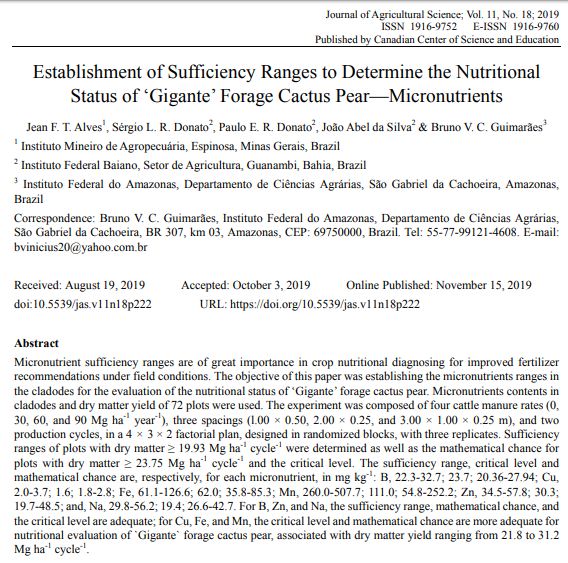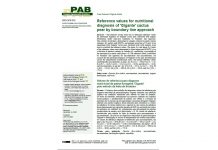Micronutrient sufficiency ranges are of great importance in crop nutritional diagnosing for improved fertilizer recommendations under field conditions. The objective of this paper was establishing the micronutrients ranges in the cladodes for the evaluation of the nutritional status of ‘Gigante’ forage cactus pear. Micronutrients contents in cladodes and dry matter yield of 72 plots were used. The experiment was composed of four cattle manure rates (0, 30, 60, and 90 Mg ha-1 year-1), three spacings (l.00 × 0.50, 2.00 × 0.25, and 3.00 × 1.00 × 0.25 m), and two production cycles, in a 4 × 3 × 2 factorial plan, designed in randomized blocks, with three replicates. Sufficiency ranges of plots with dry matter ≥ 19.93 Mg ha-1 cycle-1 were determined as well as the mathematical chance for plots with dry matter ≥ 23.75 Mg ha-1 cycle-1 and the critical level. The sufficiency range, critical level and mathematical chance are, respectively, for each micronutrient, in mg kg-1: B, 22.3-32.7; 23.7; 20.36-27.94; Cu, 2.0-3.7; 1.6; 1.8-2.8; Fe, 61.1-126.6; 62.0; 35.8-85.3; Mn, 260.0-507.7; 111.0; 54.8-252.2; Zn, 34.5-57.8; 30.3; 19.7-48.5; and, Na, 29.8-56.2; 19.4; 26.6-42.7. For B, Zn, and Na, the sufficiency range, mathematical chance, and the critical level are adequate; for Cu, Fe, and Mn, the critical level and mathematical chance are more adequate for nutritional evaluation of `Gigante` forage cactus pear, associated with dry matter yield ranging from 21.8 to 31.2 Mg ha-¹ cycle-¹.
Keywords: Opuntia ficus-indica, fertilization, nutritional evaluation





